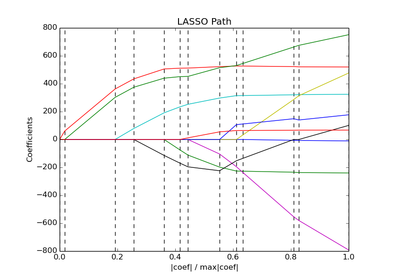sklearn.linear_model.lars_path¶
- sklearn.linear_model.lars_path(X, y, Xy=None, Gram=None, max_iter=500, alpha_min=0, method='lar', copy_X=True, eps=2.2204460492503131e-16, copy_Gram=True, verbose=0, return_path=True)¶
Compute Least Angle Regression or Lasso path using LARS algorithm [1]
The optimization objective for the case method=’lasso’ is:
(1 / (2 * n_samples)) * ||y - Xw||^2_2 + alpha * ||w||_1
in the case of method=’lars’, the objective function is only known in the form of an implicit equation (see discussion in [1])
Parameters: X : array, shape: (n_samples, n_features)
Input data.
y : array, shape: (n_samples)
Input targets.
max_iter : integer, optional (default=500)
Maximum number of iterations to perform, set to infinity for no limit.
Gram : None, ‘auto’, array, shape: (n_features, n_features), optional
Precomputed Gram matrix (X’ * X), if 'auto', the Gram matrix is precomputed from the given X, if there are more samples than features.
alpha_min : float, optional (default=0)
Minimum correlation along the path. It corresponds to the regularization parameter alpha parameter in the Lasso.
method : {‘lar’, ‘lasso’}, optional (default=’lar’)
Specifies the returned model. Select 'lar' for Least Angle Regression, 'lasso' for the Lasso.
eps : float, optional (default=``np.finfo(np.float).eps``)
The machine-precision regularization in the computation of the Cholesky diagonal factors. Increase this for very ill-conditioned systems.
copy_X : bool, optional (default=True)
If False, X is overwritten.
copy_Gram : bool, optional (default=True)
If False, Gram is overwritten.
verbose : int (default=0)
Controls output verbosity.
return_path: bool, (optional=True) :
If return_path==True returns the entire path, else returns only the last point of the path.
Returns: alphas: array, shape: [n_alphas + 1] :
Maximum of covariances (in absolute value) at each iteration. n_alphas is either max_iter, n_features or the number of nodes in the path with alpha >= alpha_min, whichever is smaller.
active: array, shape [n_alphas] :
Indices of active variables at the end of the path.
coefs: array, shape (n_features, n_alphas + 1) :
Coefficients along the path
See also
lasso_path, LassoLars, Lars, LassoLarsCV, LarsCV, sklearn.decomposition.sparse_encode
References
[R36] “Least Angle Regression”, Effron et al. http://www-stat.stanford.edu/~tibs/ftp/lars.pdf [R37] Wikipedia entry on the Least-angle regression [R38] Wikipedia entry on the Lasso


